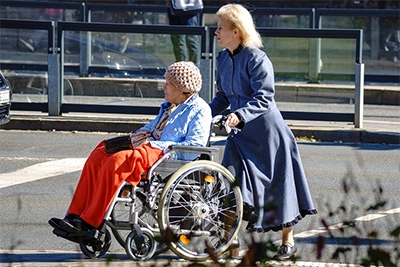Paralysis
Six million people
| Download this episode | There are nearly six million people in the United States living with paralysis. Six million people who can’t use their arms and or legs. Six million people who spend the majority of their day in a bed or wheelchair. That’s roughly the same number of people in the combined populations of Los Angeles, Philadelphia and Washington, D.C. Some were born with the condition while others were paralyzed due to illness or injury. Paralysis is the loss of muscle function in part of the body. It happens when something goes wrong with the way messages pass between the brain and the body’s muscles. Paralysis can be complete or partial. It can occur on one or both sides of the body. It can also occur in just one area, or it can be widespread. Paralysis of the lower half of the body, including both legs, is called paraplegia. Paralysis of the arms and legs is called quadriplegia. Some forms of paralysis are temporary while others occur in the form of stiffness and weakness. | The leading cause of paralysis is stroke. More than 1.8 million Americans have been paralyzed due to a stroke. A stroke occurs when the blood supply to part of the brain is suddenly blocked or when a blood vessel in the brain bursts, spilling blood into the spaces surrounding brain cells. In the same way that a person suffering a loss of blood flow to the heart is said to be having a heart attack, a person with a loss of blood flow to the brain or sudden bleeding in the brain can be said to be having a “brain attack.” Paralysis is a common feature of stroke, often on one side of the body, a condition known as hemiplegia. The paralysis or weakness may affect only the face, an arm, or a leg or may affect one entire side of the body and face. A person who suffers a stroke in the left hemisphere of the brain will show right-sided paralysis or paresis. Conversely, a person with a stroke in the right hemisphere of the brain will show deficits on the left side of the body. | Spinal cord injuries commonly lead to paralysis. The National Spinal Cord Injury Statistical Center estimates there will be approximately 18,000 new cases of spinal cord injury in the U.S. this year. Such injuries involve damage to the nerves within the bony protection of the spinal canal. The most common cause of spinal cord dysfunction is trauma, including auto accidents, falls, acts of violence and sports injuries. Damage can also occur from various diseases acquired at birth or later in life, from tumors, electric shock, and loss of oxygen related to surgical or underwater mishaps. The spinal cord does not have to be severed in order for a loss of function to occur. The spinal cord can be bruised, stretched, or crushed. Since the spinal cord coordinates body movement and sensation, an injured spinal cord loses the ability to send and receive messages from the brain to the body’s system that controls sensory, motor, and autonomic function. | Spinal cord injuries fall into two categories, complete or incomplete. With a complete spinal cord injury, the cord can’t send signals below the level of the injury. As a result, the patient is paralyzed below the injury. With an incomplete injury, the patient will have some movement and sensation below the injury. While there’s almost always hope of recovering some function after a spinal cord injury, it is generally accepted that people with incomplete injuries have a better chance of achieving some form of recovery. Currently, there is no cure for spinal cord injuries but immediate treatment can reduce the injury’s long-term effects. Treatments may include medications, braces or traction to stabilize the spine, and surgery. Later treatment usually includes medicines and rehabilitation therapy. Mobility aids, such as a wheelchair or crutches, and assistive devices may help the patient to get around and do some daily tasks. | People who have been paralyzed due to illness or an accident are likely to suffer a number of secondary conditions. Chief among these is bladder control. The nerves controlling these organs attach to the very base of the spinal cord and are therefore cut off from brain input. Although it may not be possible to regain the control one had before paralysis, a wide range of techniques and tools are available to manage what is termed a neurogenic bladder. People with a spinal cord injury are at particular risk for deep vein thrombosis, a blood clot that forms in a vein deep in the body, most often in the lower leg or thigh. This can result in a life-threatening danger if the clot breaks loose from the leg vein and finds its way to the lung, causing a pulmonary embolism. Many people who are paralyzed require mechanical assistance to breathe, not because of any problem with their lungs but due to problems with the muscles in the chest, abdomen and diaphragm.
Transcript
Stroke the leading cause
Transcript
Spinal cord injuries
Transcript
Complete and incomplete
Transcript
Secondary conditions
Transcript
